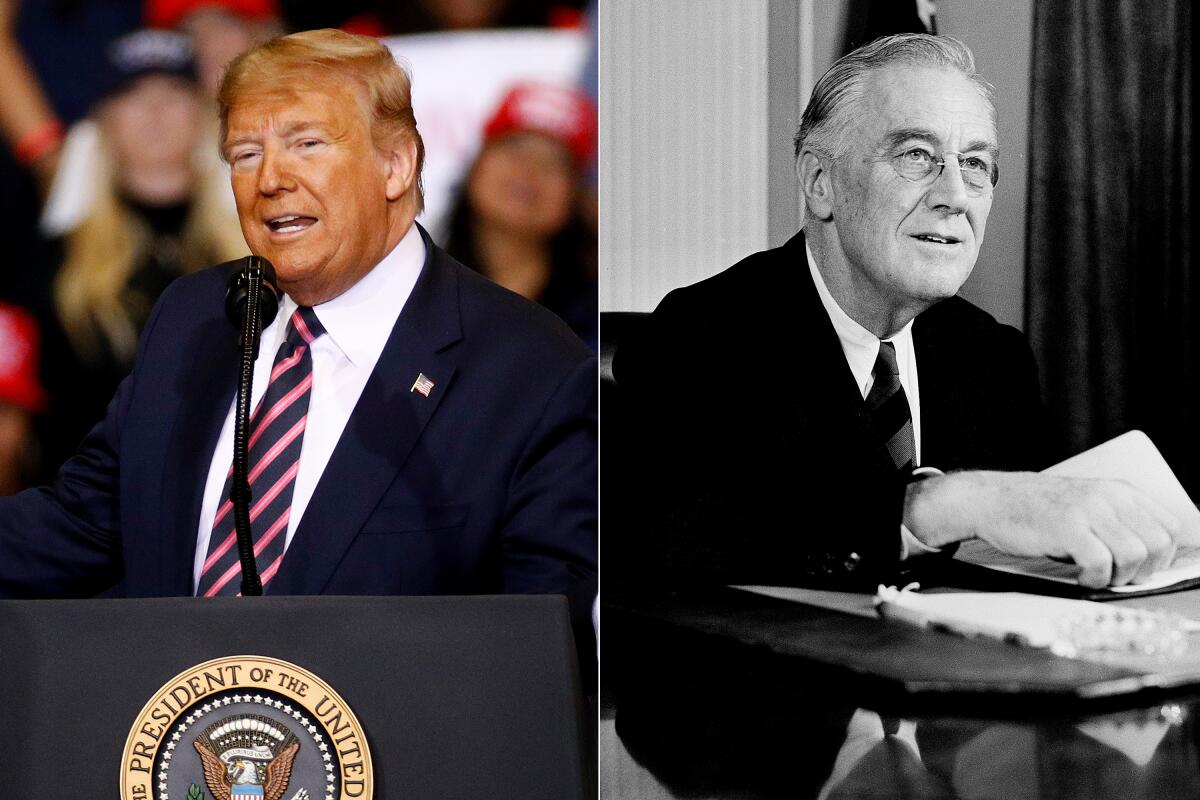A ‘Pearl Harbor moment’? Maybe. But Trump is no FDR

- Share via
When U.S. Surgeon General Jerome Adams said recently that the coronavirus crisis would “be our Pearl Harbor moment,” he unwittingly opened a debate on President Trump’s leadership amid the COVID-19 catastrophe. He was alluding to Dec. 7, 1941 — when more than 3,500 American soldiers and civilians were killed or wounded in the surprise Japanese attack — and today’s deaths, but his comment also reminds us of the extraordinary differences between the divisive presidency of Donald Trump and the unifying presidency of Franklin D. Roosevelt.
For years prior to Pearl Harbor, FDR attempted to build bridges to his Republican opponents and encourage them to support his government. When the U.S. finally entered World War II, that outreach helped to bring the nation together in an all-out war effort. Trump, on the other hand, has savaged his Democratic opponents and other perceived enemies at every turn, hindered America’s ability to stamp out the pandemic and put the U.S. into the running for the nation with the least effective response to COVID-19.
Recent reporting makes it clear that Trump had ample warning of the pandemic and its potential toll on human life and the economy at least as early as Jan. 29, and yet at a campaign rally in late February, the president was still dismissing the novel coronavirus as the Democrats’ “new hoax.” In a single phrase, he mocked legitimate worries about COVID-19; disregarded disaster warnings from scientists, intelligence agencies and others in his administration; and accused the Democrats (again) of dirty tricks.
Roosevelt’s record was very different indeed. Without belittling Republicans, throughout the 1930s he repeatedly appealed to isolationist members of both parties to awaken to the dangers of fascism. Then, nearly two years before the attack on Pearl Harbor, FDR brought two prominent Republicans, Henry Stimson and Frank Knox, into his Cabinet in a bid to unite the nation in support of his effort to prepare for war against Germany and Japan.
In our “Dispatches From the Pandemic” series, we bring you personal stories from people whose lives have been altered by COVID-19.
Stimson had served as secretary of War under one previous Republican president and secretary of State under another. Knox, a newspaper publisher and sharp critic of FDR’s New Deal, had run unsuccessfully as the GOP’s vice presidential candidate in 1936. Stimson was named secretary of War, and Knox, secretary of the Navy in June 1940. FDR said the appointments were aimed at building “national solidarity.”
Would Trump ever try to build bipartisan unity by asking the 2016 Democratic vice presidential candidate, Virginia Sen. Tim Kaine, to join his Cabinet? It’s unimaginable.
Roosevelt specifically wanted advisors who would challenge him. Less than two weeks after Pearl Harbor, it was Knox who convinced FDR that the Navy should issue a report bluntly acknowledging that American forces “were not on alert against the surprise air attack on Hawaii.” Critics question whether Knox’s admission and FDR’s launch of an investigation did enough to acknowledge government failures at Pearl Harbor, but they were at least first steps toward transparency. We will wait forever for the Trump administration to make a candid admission about missteps on COVID-19.
Unfortunately, Trump has repeatedly shown that he fears internal debate, prefers the company of sycophants and yes men, and can’t admit even the dangers of the pandemic, let alone his too-little, too-late reaction. He has repeatedly dismissed appointees — his chief of staff, his secretary of Defense, his national security advisor — who dared to disagree with him, and undermined others (Dr. Anthony Fauci, for one).
There have been some “national solidarity,” bipartisan moments in the coronavirus crisis, but they have come in spite of Trump, not because of his leadership. Democrats and Republicans in Congress joined to pass a massive COVID-19 response bill last month. Still, it was largely a transactional measure, and the next phase of legislative relief is mired in partisan politicking that Trump is exacerbating.
Trump has said no one could have known what the coronavirus would become; Roosevelt, Stimson and Knox anticipated war early on. Nearly a year before Japan attacked, in early 1941, they convinced Congress to launch the massive, expensive Lend-Lease program. It dramatically expanded production of aircraft, battleships and other materiel necessary to help our allies fight the Nazis and, not coincidentally, gave the U.S. a running start on its own defenses. In contrast, although America’s vulnerability to a viral epidemic was proved by federal studies in recent years, the Trump administration repeatedly sought cuts in the budget of the Centers for Disease Control and Prevention, and in 2018, Trump’s national security advisor, John Bolton, disbanded a team working within the National Security Council to address the threat of pandemics.
After Pearl Harbor, FDR and his Republican allies were positioned to work together with career military leaders like Gen. George C. Marshall and Adm. Chester Nimitz to lead a carefully planned, all-hands war effort over the next four years. Trump, even once the federal “stay at home” guidelines were announced, and as states have struggled for masks and ventilators, has repeatedly rebuffed calls from health experts, legislators and governors for broad federal coordination of resources and infrastructure to fight COVID-19.
Jay Inslee, the Democratic governor of Washington, pointing to Adams’ Pearl Harbor comparison, commented on Trump’s pattern of avoiding a national mobilization effort by pushing responsibility onto states: “Can you imagine if Franklin Delano Roosevelt said, ‘I’ll be right behind you, Connecticut. Good luck building those battleships.’ ”
The loss of life and the national sense of tragedy may make the early months in the COVID-19 pandemic seem like a repeat of the days and weeks after Dec. 7, 1941. But with Trump in the White House, this isn’t a Pearl Harbor moment. The American people sadly have no reason to expect anything like the extraordinary leadership that FDR displayed in uniting us to achieve victory in World War II.
Peter Shinkle is writing a book, “Uniting America,” about America’s bipartisan leadership during World War II.
More to Read
A cure for the common opinion
Get thought-provoking perspectives with our weekly newsletter.
You may occasionally receive promotional content from the Los Angeles Times.










